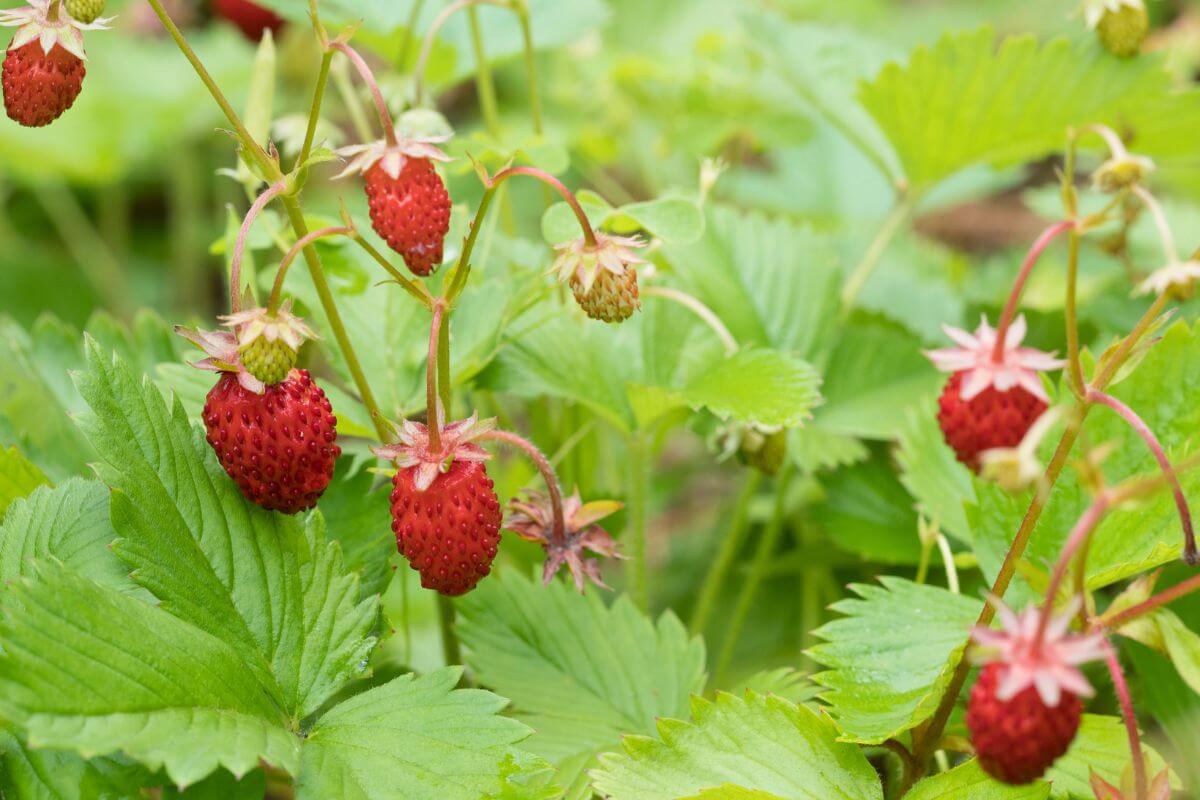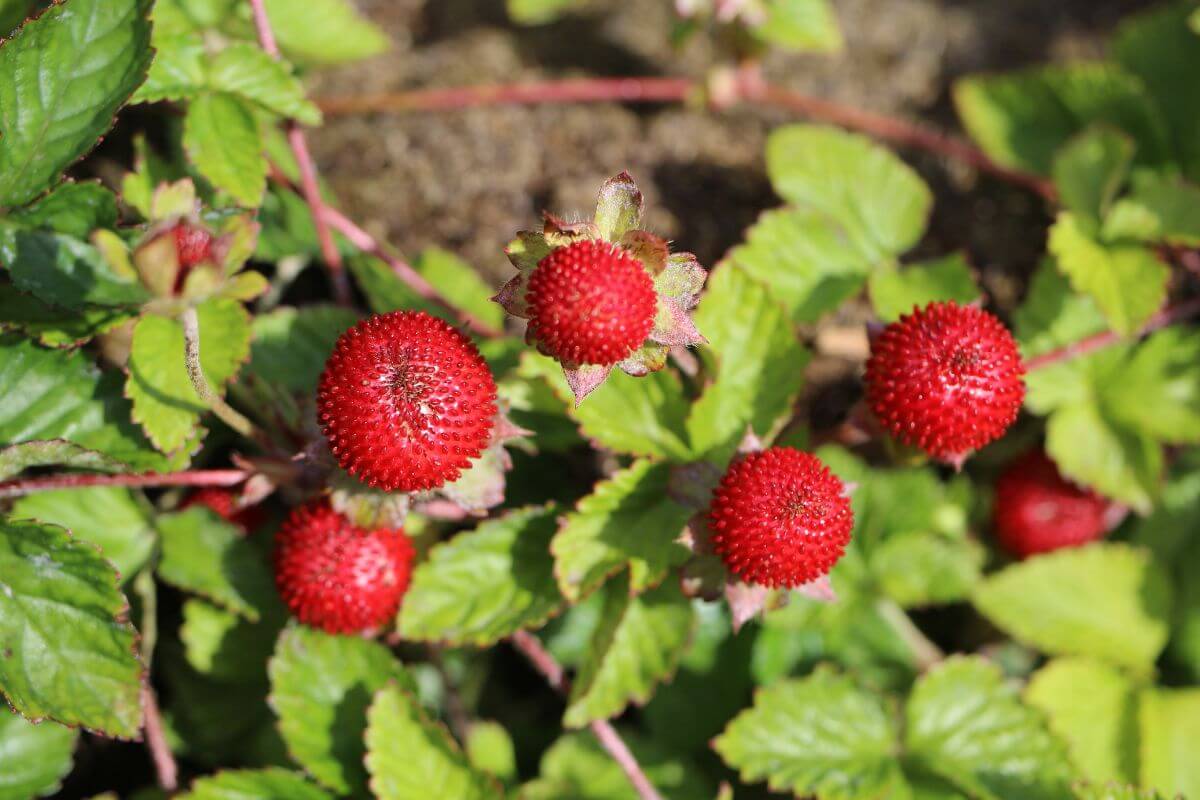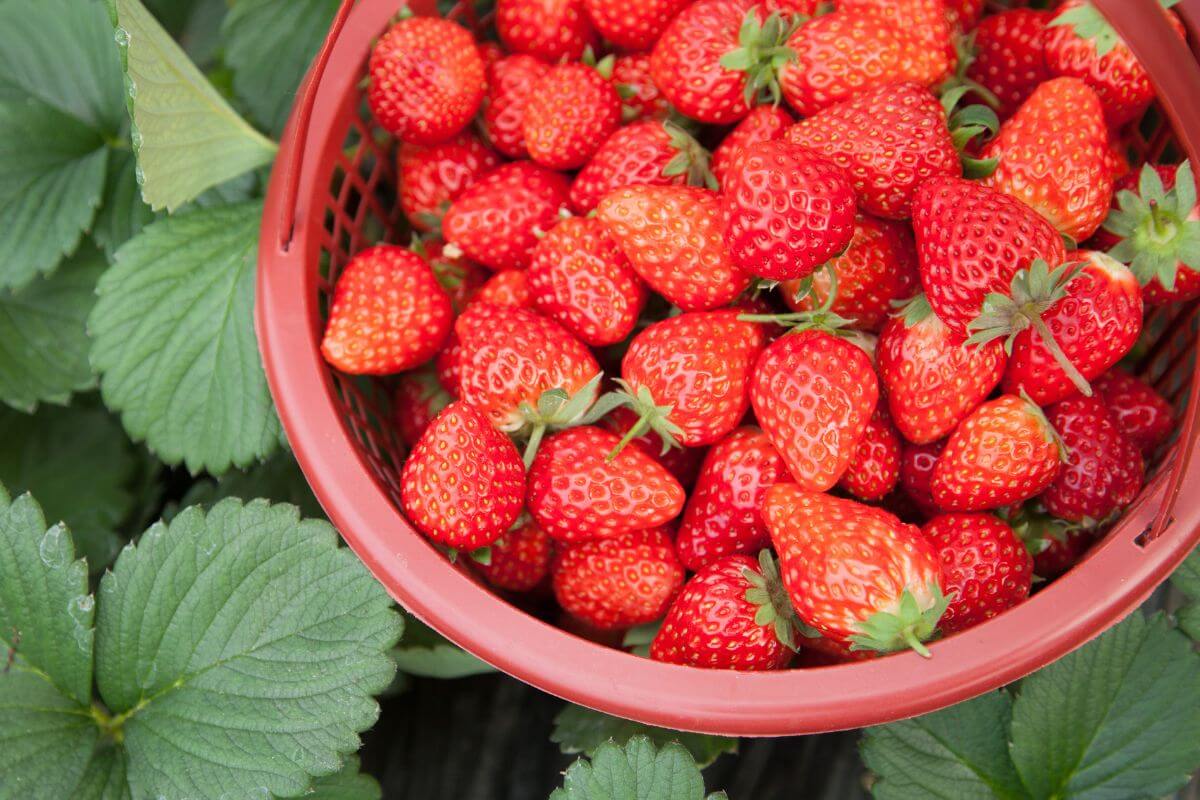Wild strawberries are some of the most common wild fruit. They are widespread in woodlands and fields and are very easy to harvest.
Despite the name, strawberries aren’t classified as true berries botanically. This is because fruit is defined as the enlargement of the plant’s ovaries. This means that the strawberry is an aggregate fruit. The true fruit is the achenes — the tiny, black dots on the surface of the strawberry that are often called seeds.
I will explore the important things you need to know about wild strawberries. Most importantly, I’ll answer the question: can you eat wild strawberries? I’ll also discuss its health benefits and how you can grow them at home.
- Related article: Kinds of Wild Edible Plants
7 Key Takeaways on Can You Eat Wild Strawberry
- Wild strawberries are safe to eat straight from their natural habitats.
- Wild strawberries offer a summery flavor. They are often sweeter and more intense than store-bought strawberries.
- Fresh strawberries are packed with vitamin C, potassium, and antioxidants. They benefit overall health.
- Wild strawberries are found in woodlands and fields. They are easy to harvest and enjoy.
- The juicy fruits of wild strawberries are deliciously tasty and can be eaten fresh. Because of their incredible flavor, they are also added to salads or used in desserts.
- You can cultivate wild strawberries at home, enhancing your garden’s natural charm.
- Wild strawberries are different from mock strawberries. They are flavorful and nutritious, offering a delightful culinary experience.
Can You Eat Wild Strawberries?

It’s perfectly safe to eat wild strawberries. For some reason, many people believe wild strawberries are poisonous. Let me assure you that they are not toxic, and no harmful substances exist in any part of this plant.
They’re delicious, too. The taste of the fruits can vary widely. They can be very sweet with a classic strawberry taste. They can also be bland and mild. Some types have tropical or raspberry-like flavors. Occasionally, you might find a plant that produces flavorless fruit.
Wild strawberries are known as delectable treats. The juicy berries are best eaten fresh, added to fruit salads, or used in desserts. You can also make them into jam, jelly, or fruit wine. You can even use wild strawberries to make ice cream for a cool summertime treat.
When using the rest of the strawberry plant, you can brew herbal tea from wild strawberry leaves. You can do this just like you can with cultivated strawberry leaves. The leaves are made up of three serrated edges with pale undersides.
However, you must be careful when picking wild strawberries. Other factors could prevent them from being eaten fresh. When harvesting any other wild plant, you must know what you’re doing. Here are some steps you can take:
- Be Mindful of Where You’re Foraging – Don’t pick fruits in areas that could be contaminated. For instance, avoid the vicinity of roads or industrial areas.
- Avoid the Paths Most Often Taken by Dog Owners – Strawberries grow close to the ground. So, they are an easy target for dogs answering nature’s call. Always wash the strawberries first (which is a good idea with any fruit or plant).
- Ensure You Correctly Identify the Plant Before Eating – No poisonous wild plants closely resemble strawberries. The only risk is picking Indian mock strawberries, which we will explain shortly.
Wild strawberries naturally grow in Europe, South America, North America, and Asia. They range in size. Those native plants in woodlands differ from the ones we grow in gardens.
Are There Health Benefits to Eating Wild Strawberries?
The first recorded evidence of strawberries in the archeological record dates back to the Mesolithic era (Middle Stone Age). It occurred between 10,000 and 5,000 BCE. Wild strawberries have had many health benefits since ancient times. These include:
- Boosts Immune System – Wild strawberries are an excellent source of vitamin C. It is great for the immune system.
- Improves Heart and Bone Health – Wild strawberries have good potassium levels. It is an important mineral for heart and bone health.
- Reduces Heart Disease – The wild strawberry plant is rich in anthocyanins. These are antioxidants that can help reduce heart disease.
- Anti-Inflammatory – Wild strawberries contain quercetin, a flavonoid with anti-inflammatory properties.
- Prevents Breast Cancer – Wild strawberries have also been reported as the second-best fruit for preventing breast cancer after grapes (source).
- Helps With Sleep and Appetite Loss – The folate in wild strawberries is a mood regulator. It can help with sleep and appetite loss.
- Herbal Medicine – The roots of wild strawberries have been used in herbal medicine, often in tea. Some Native American groups used tea from the roots as a spring tonic, digestive tonic, and blood purifier.
Many of these substances can also be found in regular strawberries, just in lower concentrations.
What Are the Most Common Types of Wild Strawberries?
There are more than 20 species of wild strawberries, and many of them can mix together. They can be hard to tell apart, but the good news is that they are all safe to eat. Some of the most common types include:
| Strawberry Type | Scientific Name | Native Regions | Characteristics |
| Virginia Strawberry | Fragaria virginiana | North America | The Virginia Strawberry has sweet, small, round berries. It has white, five-petaled flowers. The leaves are trifoliate, green on top and pale beneath. |
| Woodland or European or Alpine Strawberry | Fragaria vesca | Northern Hemisphere | The Woodland Strawberry has strongly flavored, rounded berries. Its light green, trifoliate leaves are topped with hairy white flowers. |
| Chilean or Beach Strawberry | Fragaria chiloensis | North and South America | The Chilean Strawberry has thick, glossy green leaves. It has white flowers. The fruits are red outside and white inside. It is a tender strawberry native to warm temperate areas. |
| Musk or Hautboy Strawberry | Fragaria moschata | Europe | The Musk Strawberry has an intense flavor combining pineapple and raspberry. It thrives in moist forest edges. |
- Learn more in our Edible Wild Berries Guide
Wild Strawberry vs Mock Strawberry: What Is the Difference?

Mock strawberries (Potentilla Indica, or sometimes Duchesnea Indica) are also known as Indian strawberries. They are also called backyard strawberries, wood strawberries, and false strawberries.
Mock strawberries grow in conditions similar to wild strawberries, and they are often mistaken for the wild variety. The two are not closely related, even though they belong to the same Rosaceae family.
Mock strawberries are a bunch of fleshy seeds that are bright red with a mild and unclear taste. The leaves look like mint leaves but have notches like true strawberry foliage. If you know what to look for, it will be easy to tell if the plant in front of you is the one you want. You can differentiate them by their:
- Growth Direction – Mock strawberries grow upwards while wild strawberries grow toward the ground. This is the main cue and the easiest way to recognize the plant quickly.
- Color – If the fruits are not yet present, the color of the flowers will help you distinguish between the two. The wild strawberry plant has pinkish or white flowers, while the mock strawberry plant has yellow flowers.
The good news is that even if you eat some mock strawberries by mistake, there will be nothing to worry about. They are perfectly edible. They are just not tasty and will leave you unsatisfied if you were expecting the sweet juiciness of wild strawberries.
Wild Strawberry vs Regular Strawberry: What Is the Difference?

It might not be surprising that the regular and common strawberries sold in stores and grown on farms aren’t the same species as the wild ones.
The most noticeable difference between the wild strawberry and the regular, modern strawberry is its size and longevity. The regular strawberries are bigger and last longer. Wild strawberries go bad quickly once picked, so they aren’t commercially popular.
Another difference is the flavor. Being tiny can seem like a negative, but it means that their flavor is much more concentrated. Wild strawberries are much sweeter, taste stronger, and are more flowery.
The modern strawberry is the result of centuries of artificial selection, which has created bigger fruits with longer shelf lives than their wild relatives. It is a hybrid created in the 1700s in France by cross-breeding two wild species native to Chile, Fragaria Virginiana and Fragaria Chiloensis.
Can You Grow Wild Strawberries at Home?
Wild strawberries can be grown at home. It’s very easy to cultivate them in your garden. If you have a natural area or an abundant patch, you can grow wild strawberries from seed or transplant strawberries from runners.
Tips for Growing Wild Strawberries at Home:
- Planting – Start with a few plants, and they will spread through runners, forming a thick ground cover.
- Optimal Conditions – Grow best in cool temperatures of spring and fall, and can go dormant in extreme weather.
- Soil – Prefer rich, moist soils. Enrich poor soil with mature compost.
- Sunlight – Thrive in full sun or partial shade.
- Mulching – Mulch with chopped straw in summer to retain moisture and prevent weeds; use organic mulch to enrich soil.
- Winter Care – Apply a thick layer of mulch in winter to protect roots, and remove it in spring.
- Maintenance – Low maintenance once established; water during warmer months.
- Harvesting – Harvest daily from April to June to prevent bugs and animals from eating the ripe fruits.
Can You Eat Wild Strawberry Final Thoughts
Wild strawberries are an amazing food source and are great to eat. These edible strawberries have a unique, sweet flavor that is hard to find on regular strawberries in grocery stores.
They are small and delicious and don’t require any special preparation. If you want to try eating wild strawberries, you must know where to look. You’ll find them out in the fields and forests.
So, if you’re out on a hike, don’t be afraid to eat them when you see them.
Can You Eat Wild Strawberry FAQs
1. Can You Eat Wild Strawberry Seeds?
You can eat wild strawberry seeds. They are safe to eat and are often eaten along with the fruit.
2. Are Wild Strawberries Poisonous?
Wild strawberries are not poisonous. They are safe to eat and taste similar to regular strawberries.
3. Can Dogs Eat Wild Strawberries?
Dogs can eat wild strawberries in moderation. They are safe and can be a healthy treat for dogs.
4. Are Wild Strawberries Sweet?
Wild strawberries are sweet. They often have a more intense flavor compared to regular strawberries.
5. Where Do Wild Strawberries Grow?
Wild strawberries grow in various places, including forests, fields, and roadsides. They prefer sunny spots with well-drained soil.
Read more about other edible plants:

